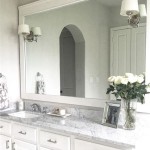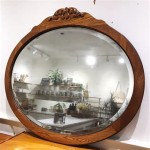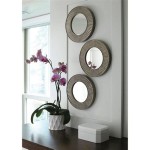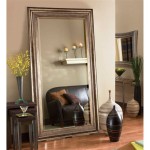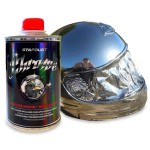Molding for Mirrors: Enhancing Aesthetics and Functionality
Mirror molding serves both aesthetic and functional purposes. It provides a decorative frame, enhancing the mirror's visual appeal while also protecting the edges from chipping and damage. Furthermore, molding can help secure the mirror to the wall, offering added stability. Selecting the right molding requires careful consideration of various factors, including the mirror's size, shape, existing décor, and desired overall effect.
Key Considerations for Choosing Mirror Molding
Several factors influence the choice of appropriate mirror molding. Understanding these key elements ensures a cohesive and visually appealing final result.
*Mirror Size and Shape: Larger mirrors often benefit from wider, more substantial molding, while smaller mirrors may appear overwhelmed by heavy frames. The shape of the mirror also dictates the molding profile; curved mirrors require flexible molding, while rectangular or square mirrors offer more versatility.
*Existing Décor: The molding should complement the existing décor of the room. Consider the overall style, whether traditional, modern, or eclectic, and choose a molding profile that harmonizes with the existing elements.
*Material: Molding materials range from wood and plaster to metal and synthetic composites. Each material offers different aesthetic qualities and levels of durability. Wood provides a classic look, while metal offers a more contemporary feel.
*Budget: Molding costs vary significantly depending on the material, complexity of the profile, and overall length required. Establish a budget beforehand to narrow down the options and make informed decisions.
Popular Molding Materials
The choice of molding material impacts the overall look and durability of the framed mirror. Each material possesses unique characteristics that make it suitable for different applications.
*Wood Molding: A classic and versatile choice, wood molding offers a wide range of profiles and finishes. It can be painted, stained, or left natural to complement various décor styles. Wood is relatively easy to work with and readily available.
*Plaster Molding: Plaster molding allows for intricate designs and ornate detailing. It is often used in traditional or historical settings to create a sense of grandeur. Plaster requires more specialized installation and may be more susceptible to damage than other materials.
*Metal Molding: Metal molding, such as aluminum or stainless steel, provides a sleek and modern aesthetic. It is durable and resistant to moisture, making it suitable for bathrooms or humid environments.
*Polyurethane Molding: Polyurethane molding is a lightweight and cost-effective alternative to wood or plaster. It is easy to install and resistant to moisture and insects. A wide range of profiles mimics the look of traditional materials.
Installation Techniques for Mirror Molding
Proper installation ensures a secure and aesthetically pleasing result. The specific installation method varies depending on the type of molding and the mirror's size and weight.
*Adhesive Application: Lightweight molding can often be installed using construction adhesive. Ensure the mirror and molding surfaces are clean and dry for optimal adhesion.
*Mechanical Fasteners: Heavier moldings or large mirrors may require mechanical fasteners, such as screws or nails, for added security. Use appropriate anchors for the wall material to ensure a stable installation.
*Mitered Corners: Creating precise mitered corners is crucial for a professional-looking finish. Use a miter saw or miter box to cut accurate angles for seamless joints.
*Finishing Touches: Caulk can be used to fill any gaps between the molding and the mirror or wall. Painting or staining the molding completes the look and provides added protection.
Maintaining Mirror Molding
Regular maintenance helps preserve the appearance and longevity of the mirror molding.
*Cleaning: Dust the molding regularly with a soft cloth. For more thorough cleaning, use a damp cloth and mild detergent. Avoid abrasive cleaners that can scratch the surface.
*Repairs: Address any chips or cracks in the molding promptly to prevent further damage. Wood filler or epoxy can be used to repair minor imperfections.
*Refinishing: Periodically refinishing wood molding with paint or stain can revitalize its appearance and provide added protection.
Choosing the Right Style
The style of molding significantly impacts the overall aesthetic. Consider the desired look and feel when selecting a profile.
*Traditional Styles: Ornate profiles with intricate detailing, such as egg-and-dart or dentil molding, create a classic and elegant look.
*Modern Styles: Simple, clean lines and geometric shapes characterize modern molding profiles. Flat or slightly beveled edges offer a minimalist aesthetic.
*Transitional Styles: Transitional styles blend elements of traditional and modern design. Subtle curves and understated detailing provide a versatile look.
Framing Options beyond Traditional Molding
While traditional molding remains a popular choice, alternative framing options offer unique and creative possibilities.
*Repurposed Materials: Reclaimed wood, antique picture frames, or other salvaged materials can create a unique and personalized frame for a mirror.
*Tile or Mosaic: Framing a mirror with decorative tile or mosaic adds a touch of artistry and texture.
*Rope or Fabric: Wrapping a mirror frame with rope, fabric, or other flexible materials offers a softer, more textured look.
Placement and Lighting Considerations
The placement of the mirror and the surrounding lighting significantly impact its overall effect. Consider these factors when planning the installation.
*Natural Light: Positioning a mirror opposite a window can reflect natural light and brighten a room.
*Artificial Light: Install sconces or other lighting fixtures near the mirror to enhance its functionality and create a focal point.
*Mirror Size and Room Scale: Choose a mirror size that is proportionate to the room and the surrounding furniture. A large mirror can make a small room feel larger, while a small mirror can get lost in a large space.

Mirror Molding The Easy Upgrade To Boring Bathrooms Mirrorchic

Diy Bathroom Mirror Frame With Molding The Happier Homemaker

Bathroom Mirror Framed With Crown Molding Large Mirrors Frame Makeover

How To Frame A Mirror Sand And Sisal

Mirror Molding Framing A With Crown Mirrormate
How To Upgrade Your Builder Grade Mirror Frame It

Diy Bathroom Mirror Frame With Molding The Happier Homemaker

Framing A Bathroom Mirror Tempting Thyme

Crafty Again

Diy Bathroom Mirror Upgrade Tutorial Use Mdf Trim And Crown Molding To Build A Frame Around The Home Decor Remodeling

